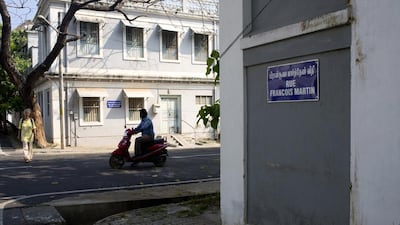Why Pondicherry?
Officially renamed Puducherry, the seaside town on the Bay of Bengal, next to Tamil Nadu, is best known for its French connection. From the late-17th to mid-20th century, Pondicherry remained a French outpost, frequented intermittently by the Dutch, the Danes and the British. Centuries of colonial influence have left an indelible mark on the culture and design of the region: the spoken language is a blend of Tamil and French; the cuisine is an amalgamation of South Indian and Mediterranean; and the architecture has a distinctly European flair.
The town is divided neatly into two quarters, separated by a narrow canal: the sleepy, sea-facing French quarter and distinctly busier Tamil quarter. The former is a neat grid of intersecting streets with French names such as Rue Saint Martin and Rue Labourdonnais, where slow living and unhurried meals are the order of the day.
A comfortable bed
In the heart of the French quarter on Rue Bussy, Palais de Mahé (www.cghearth.com/palaisdemahe) is a new boutique offering. The facade wears the ochre tone so typical of Pondicherry. Tall white columns hold up high ceilings, while arches and a wraparound wooden veranda overlook the entrance. The slender pool is ideal for languid summer afternoons. With tiled floors, roof beams and four-poster beds, rooms are traditional and comfortable. Double rooms cost from 14,500 rupees (Dh784).
Le Dupleix (www.ledupleix.in) is an elegant property housed in an 18th-century French villa that was once the residence of the mayor. Tastefully restored to blend traditional Indian and French styles, the hotel now features chequered tiles and original carved woodwork from the house of Governor Joseph François Dupleix, after whom the hotel is named. In the courtyard, the al fresco restaurant in the shade of a mango tree is a major draw for visitors to Pondicherry, for its mix of European and Indian flavours. Doubles cost from 5,000 rupees (Dh270).
Find your feet
The French Quarter is a neat grid of cobbled lanes stretching from the sea-facing Goubert Avenue (or Beach Road) to the canal. Sun-dappled boulevards are lined with colonial-style mansions, many dating from the 18th century. The vibe is Mediterranean: shuttered windows on pastel-hued facades; boughs of overhanging bougainvillea adding bursts of colour; and more bicycles than cars. Navigating these lanes on foot brings out the real essence of Pondicherry. Intach (www.intachpondicherry.org), a non-profit organisation involved in restoration work in the area, conducts heritage walks.
The French Quarter trail winds past leafy open-air courtyards that now house chic restaurants, refurbished villas converted to charming hotels and many of Pondicherry’s iconic buildings, including the Sri Aurobindo Ashram and Notre Dame des Anges church. Most eye-catching among these are the sunshine-yellow frontages of the Alliance Française and French Consulate.
Meet the locals
A promenade along the length of Goubert Avenue borders the water, busy with vendors hawking fruit, ice cream and candy floss under rainbow-striped umbrellas. In the evenings, locals and tourists throng this stretch in large numbers. The main road is also car-free in the evenings, making it ideal to take in the sights and sounds. Stroll past the 19th-century lighthouse and a large Mahatma Gandhi statue. Le Café is a good spot for a cold coffee or juice, best enjoyed al fresco with a view of the sea.
Book a table
The Promenade hotel's restaurant BlueLine (www.thepromenadepondicherry.com) does a hearty breakfast buffet. For 400 rupees (Dh22), it includes fresh croissants and muffins, eggs to order, a range of cheeses and meats, hot waffles and pancakes. Alongside western options are fluffy idlis, sambar, crispy vadas and fresh dosas. An ocean view is a bonus.
Baker Street (Rue Bussy) is a study in contrasts – recreating a typical French boulangerie, but staffed by Tamil ladies in traditional saris with jasmine in their hair, offering patrons Gorgonzola and Brie in perfectly accented French. The pain au chocolate, cheese-laden quiches and flaky croissants are the best bets. Expect to pay about 500 rupees (Dh27) for two people.
Hotel de Pondicherry's garden restaurant Le Club (www.leclubraj.com) has Indian and French items on the menu, but the medium-rare steaks are the real hit. A meal for two costs about 2,000 rupees (Dh108).
Shopper’s paradise
Via Pondicherry (www.viapondichery.com) boasts a whimsical collection of breezy textiles, brightly embellished bags and kitschy home decor.
You can't miss Play Clan (www.theplayclan.com), with its black-and-yellow exterior. Shop for unique clothing, accessories and collectibles.
Curio Centre (Rue Romain Rolland) is a one-stop shop for art buffs, with Tamil collectibles and antique furniture.
What to avoid
Avoid hiring a car in the French quarter’s narrow lanes. Unlike many other Indian cities, walking or a bike will do fine.
Don’t miss
Auroville (www.auroville.org) has long drawn creative and spiritual types to its experimental township. To understand the multi-ethnic community, home to more than 40 nationalities, stop at the Auroville Visitor's Centre and the Matrimandir, which looks like a large golden golf ball.
Go there
Etihad (www.etihad.com) flies from Abu Dhabi to Chennai from Dh1,130 return, including taxes. From there, it's a two-hour drive to Pondicherry along the scenic East Coast Road.
artslife@thenational.ae

